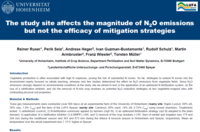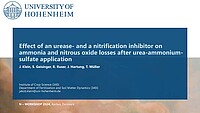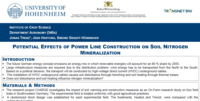The study site affects the magnitude of N2O emissions but not the efficacy of mitigation strategies
Reiner Ruser, Perik Seiz, Andreas Heger, Ivan Guzman-Bustamante, Rudolf Schulz, Martin Armbruster, Franz Wiesler, Torsten Müller
Introduction
Vegetable production is often associated with high N surpluses, posing the risk of substantial N losses. So far, strategies to reduce N losses into the environment mainly focused on nitrate leaching, whereas only few studies determined the effect on N2O emissions from vegetable fields. Since N2O emissions strongly depend on environmental conditions at the study site we aimed to test
- the application of an optimized N fertilization system,
- the use of a nitrification inhibitor, and
- the removal of N-rich crop residues as potential N2O reduction strategies at two vegetable-cropped sites with contrasting physical soil properties.
contact: reiner.ruser@uni-hohenheim.de
Supplement to the poster contribution of the N workshop, Aarhus, June 2024
Effect of an urease- and a nitrification inhibitor on ammonia and nitrous oxide losses after urea-ammonium sulfate application
Jakob Klein, Susanne Geisinger, Reiner Ruser, Jens Hartung, Torsten Müller
Incubation study on the effect of soil moisture and rainfall on NH3 emissions from different inhibited urea fertilizers
Jonas Frößl, Michael Scholl, Jens Hartung, Reiner Ruser, Torsten Müller
Introduction
- NH3 emissions are affected by soil and weather conditions after fertilizer application.
- Influence of soil water content likely not linear, low NH3 emissions only under dry and very wet soil moisture conditions.
- With medium water content: fast dissolution of the fertilizer granule, fast hydrolysis of urea, low pH buffering due to low spatial distribution in the soil, resulting in high emission potential.
- How do urease and nitrification inhibitors interact on NH3 emissions at different soil water contents and after rainfall?
contact: jonas.froessl@uni-hohenheim.de
Potential effects of power line construction on soil nitrogen mineralization
Jonas Trenz, Jens Hartung, Simone Graeff-Hönninger
Introduction
- The future German energy concept envisions an energy mix in which renewable energies will account for an 80 % share by 2050.
- Large infrastructure measures are required due to the distribution problem: wind energy has to be transported from the North to the South.
- Based on a political decision, the transport will be conducted by high-voltage direct current (HVDC) underground cables.
- The installation of HVDC underground cables causes soil disturbance through trenching and soil heating through thermal losses.
- Does soil disturbance and soil heating influence nitrogen mineralization?
contact: j.trenz@uni-hohenheim.de





